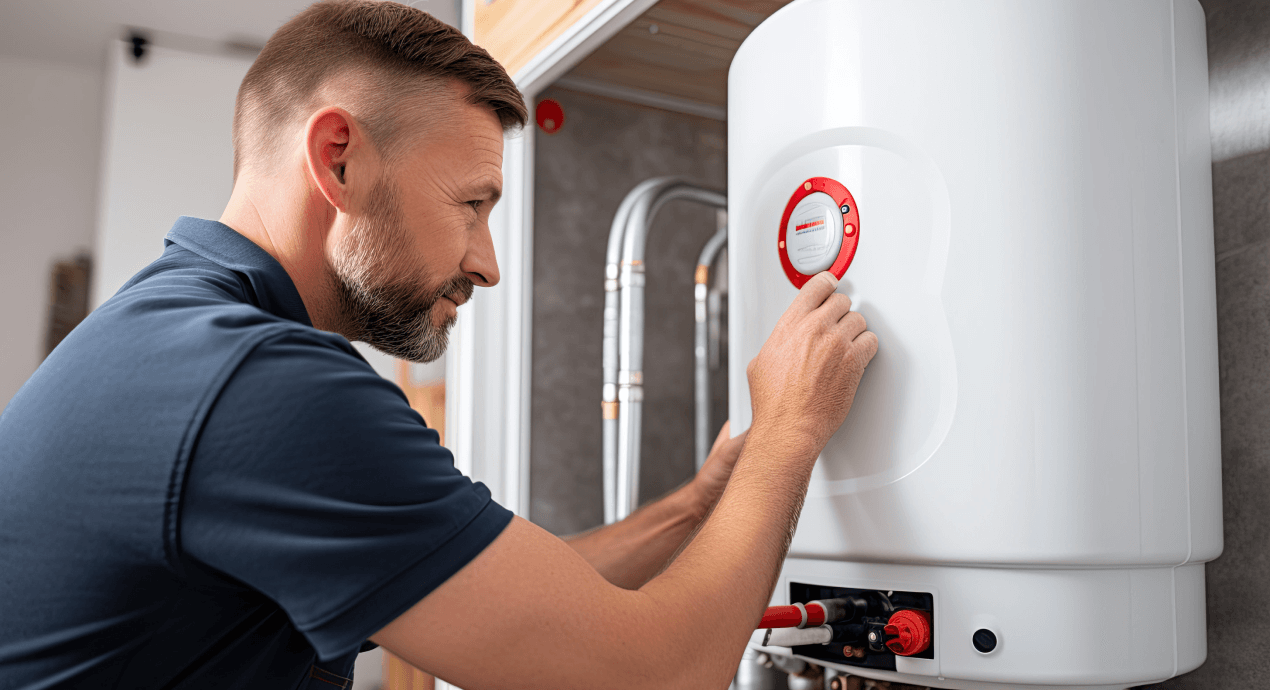
Contemplating coverage?
Subscribe to receive our emails & get
$200 OFF!
Have questions?
Call us: (833) 544-8273


Written By Allaire Conte
Finding the ideal water heater temperature is about more than personal preference—it's a careful balance between comfort, safety, and energy efficiency. Set the temperature too high, and you risk scalding accidents and inflated energy bills. Too low, and you might face lukewarm showers and potential bacteria growth, compromising both comfort and health.
The perfect temperature setting depends on your household's specific needs and priorities. For most homes, 120°F is considered optimal, as it prevents bacteria growth, minimizes scalding risks, and keeps energy usage in check. However, families with infants, elderly members, or individuals with weakened immune systems may require adjustments to enhance safety and hygiene. Additionally, homes in colder climates or those with higher water demands might benefit from a slightly higher setting to maintain a reliable supply of hot water.
There's a reason Liberty Home Guard was rated the #1 Home Warranty Service by U.S. News and World Report for 2021, 2022, 2023, and 2024. Check out our services.The Best Home Warranty Service
Water heater temperature settings aren't just about dialing in a number—they impact how efficiently your water heater runs, how safe your household is, and how much you spend on energy. Most water heaters come with a factory default setting, typically around 140°F. While this may work for some households, it's not always the best choice for every situation. Adjusting your water heater's temperature allows you to tailor its performance to meet your specific needs.
The temperature of your water heater directly affects its ability to deliver hot water on demand, prevent bacterial growth, and ensure safety. If the temperature is too low, harmful bacteria like Legionella, which causes Legionnaires' disease, can thrive in the tank. On the other hand, water that is too hot can cause scalding injuries, particularly for children and the elderly, whose skin is more sensitive. Striking the right balance is crucial for keeping your household safe and comfortable.
Most water heaters have a temperature dial located on the unit. For gas water heaters, this dial is usually near the base of the tank, while electric models often have thermostats hidden behind access panels. It's a good idea to use a thermometer to test the actual water temperature from a faucet, as the thermostat setting may not be perfectly accurate.
The "perfect" water heater temperature isn't a one-size-fits-all answer. However, experts generally agree that 120°F is the ideal setting for most homes.
At 120°F, water is hot enough to prevent bacterial growth, including Legionella, which thrives at lower temperatures. It's also cool enough to significantly reduce the risk of scalding, especially for children, elderly individuals, and those with sensitive skin. Moreover, this setting strikes a good balance for energy efficiency, helping to lower utility bills by reducing the amount of energy your water heater consumes.
Certain situations may call for increasing the water heater temperature above 120°F. For example:
In some cases, reducing the water heater temperature might make sense:
To find the perfect temperature, start by setting the water heater to 120°F and adjust incrementally based on feedback. If you find the water isn't hot enough for tasks like showers or washing dishes, gradually increase it. Conversely, if energy costs are a concern, try lowering the temperature slightly and monitor the impact on your comfort and bills.
Striking the right balance between energy efficiency and water heater temperature is key to keeping your utility bills in check without sacrificing comfort or safety. Water heating is one of the largest energy expenses in a home, accounting for about 14–18% of the average household's energy usage, according to the Department of Energy. By optimizing your water heater's temperature settings, you can reduce energy consumption while still enjoying reliable hot water.
Higher temperature settings require your water heater to work harder and use more energy to maintain the desired level of heat. For every 10°F reduction in water heater temperature, you can save approximately 3–5% on energy costs.
With a few adjustments and mindful habits, you can enjoy the best of both worlds: a safe, comfortable supply of hot water and lower energy bills. Optimizing your water heater's temperature is a simple but impactful way to improve your home's efficiency while ensuring the well-being of everyone in your household.
The time it takes for a water heater to heat up will depend on the type of water heater, its size, and the temperature of the incoming water. Understanding these variables can help you set realistic expectations and identify potential issues if your water heater isn't performing as it should.
If your water heater is taking significantly longer than average to heat up, it could indicate a problem. Sediment buildup, a failing heating element, or a malfunctioning thermostat are common culprits. Regular maintenance, such as flushing the tank annually, can improve performance and reduce heating time. If issues persist, it's wise to call a professional for repairs. Many homeowners may also find relief in their home warranty coverage, as most plans include water heaters, potentially reducing out-of-pocket repair costs.
There's a reason Liberty Home Guard was rated the #1 Home Warranty Service by U.S. News and World Report for 2021, 2022, 2023, and 2024. Check out our services.The Best Home Warranty Service
Stay Ahead of Potential
Home Mishaps!
Subscribe to our Liberty Home Guard Newsletter and gain access to exclusive content that ensures your peace of mind.